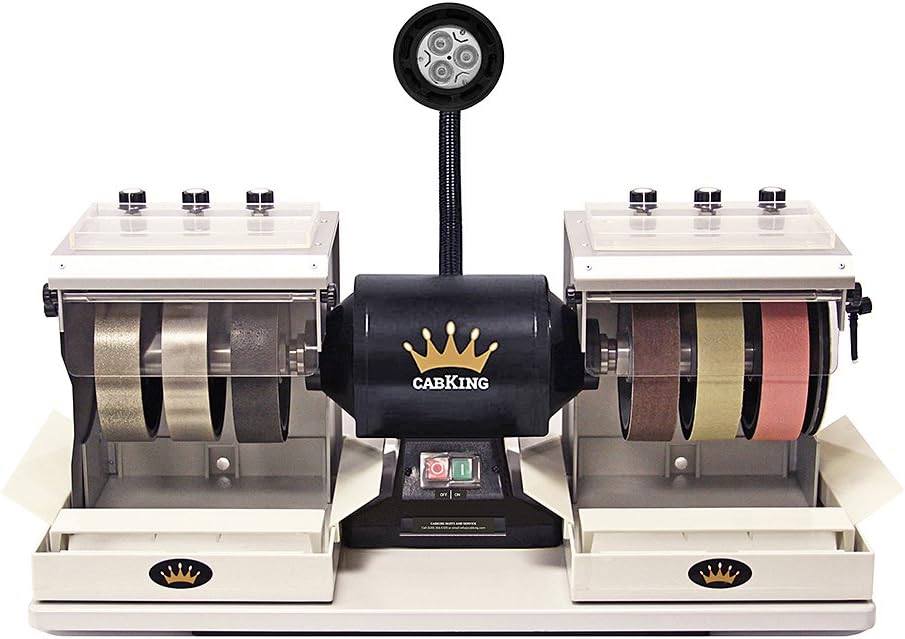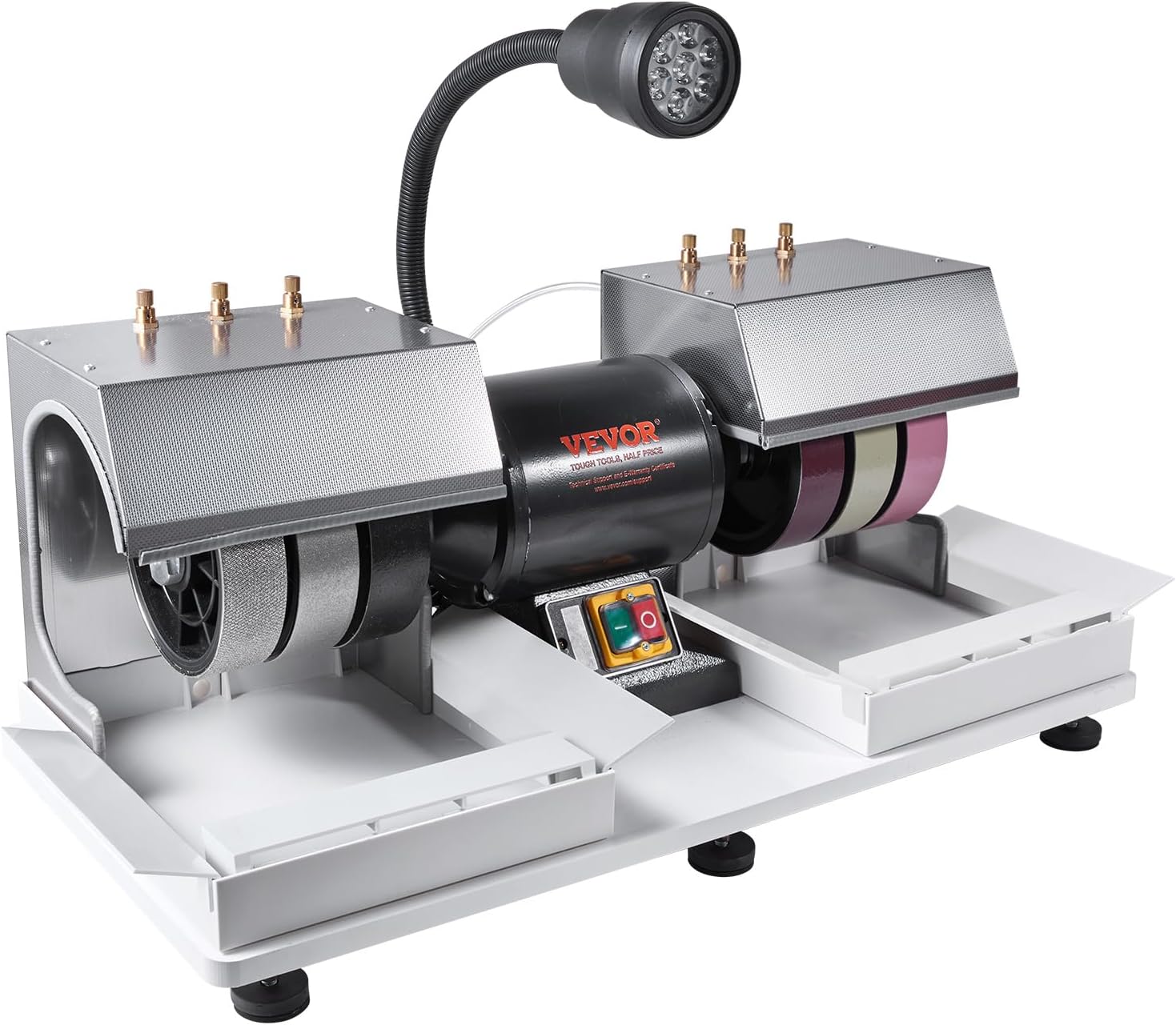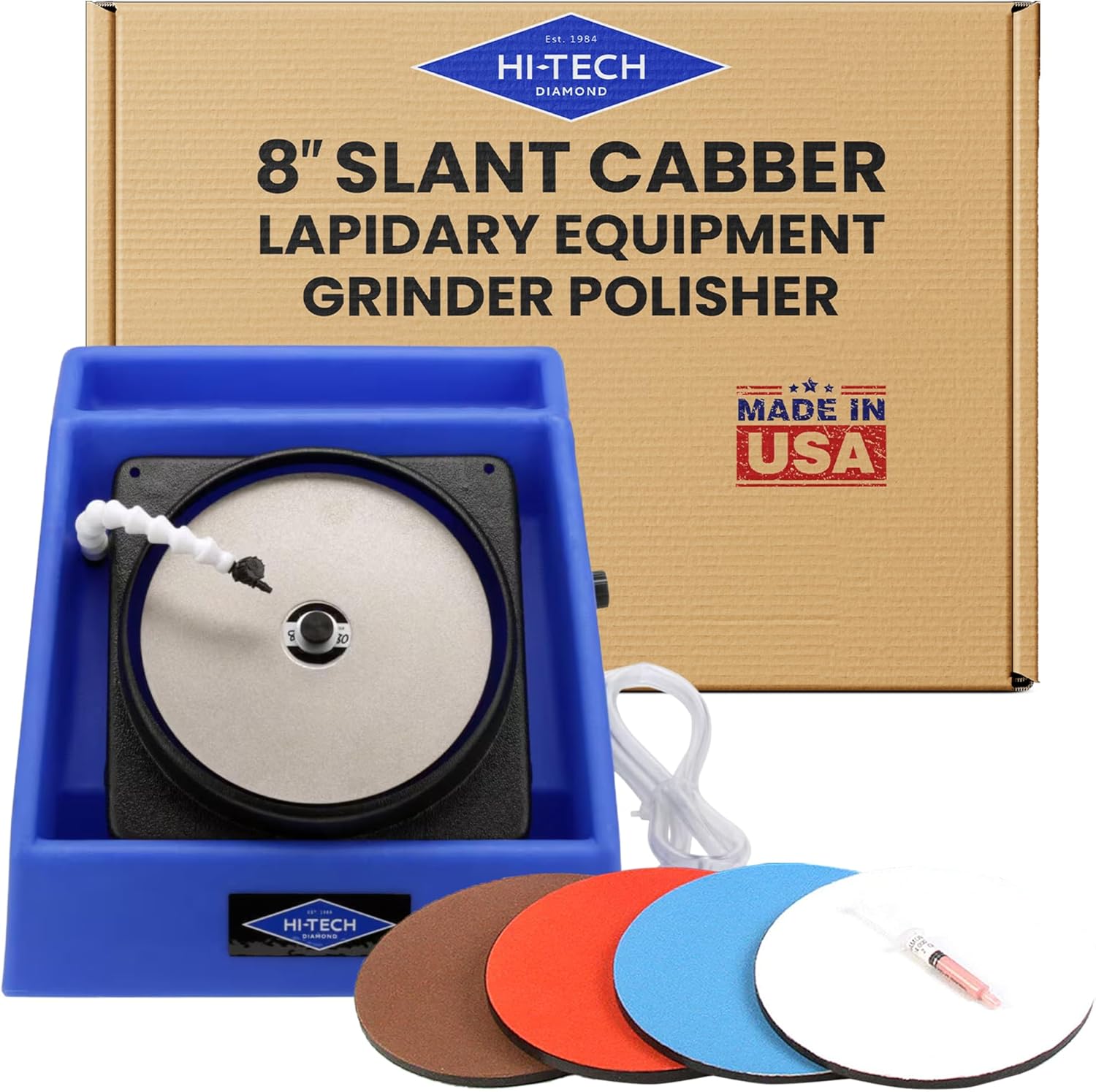Cabbing Machines That Won't Make You Regret This Hobby

That rough agate slab sitting on your workbench? A cabbing machine can turn it into a gleaming cabochon ready for a jewelry setting. These machines grind away rough surfaces with diamond wheels, then polish to a mirror finish that reveals hidden patterns and colors locked inside the stone.
Expect to spend $1,000 to $2,000 for a quality 6-inch machine. The price jump reflects real differences - some offer six wheels mounted and ready to go, others use flat lap designs where you swap grinding discs. Higher-end models include better water systems, more accessories, and US assembly with solid warranties.
Rock collectors usually discover cabbing after accumulating slabs from field trips or rock saws. There's something magnetic about transforming that dull chunk of jasper into something that catches light like jewelry store gems. The work demands patience and steady hands, but the actual process is methodical - start coarse, work through finer grits, finish with polish. Many lapidaries start with rock tumbling before moving to cabbing for more control over the final shape.
Setup requires a sturdy table and two buckets for the water system. The constant flow cools the stone and washes away grinding particles that would otherwise clog your wheels or end up in your lungs. Most people work standing at a comfortable height, though some machines offer angled designs for sitting. Proper workshop setup with adequate ventilation and drainage makes the difference between a functional space and an ongoing headache.
The machine choice comes down to workspace, budget, and whether you want all your grinding stations ready simultaneously or don't mind swapping components between steps.
CabKing 6" Cabbing Machine

The CabKing lives up to its name as the premium option in cabbing machines. At around $1,400-$1,600, it costs significantly more than alternatives, but that price reflects a complete workstation approach that eliminates the wheel-swapping routine found on cheaper machines.
Six diamond wheels come pre-mounted and ready - two electroplated diamond grinding wheels on the left shaft handle the initial shaping, while the right side houses three diamond resin wheels for progressive polishing, plus a canvas pad and full-face diamond lap for the final mirror finish. The setup means you can move seamlessly from coarse grinding to final polish without stopping to change components. Understanding grit progression helps you use each wheel effectively and avoid the common mistake of skipping stages.
The 1/4 horsepower direct-drive motor runs at a steady 1800 RPM, delivering consistent power without the belt maintenance issues that plague some machines. That fixed speed might seem limiting compared to variable-speed alternatives, but many experienced cabbers prefer the predictability for consistent results across different stone types.
CabKing's water system stands out with its single-pass design - fresh water flows to each wheel individually rather than recirculating through the system. This prevents grit contamination that can happen when dirty water carries particles from coarse wheels to finishing stages. The included 30-watt pump handles the water delivery, though you'll need to provide two buckets for clean water input and slurry collection. The diamond wheels included with these machines have different longevity depending on what stones you're cutting, so understanding blade wear helps you budget for replacements.
The machine comes assembled and tested from a US facility with a one-year warranty. Replacement wheels and accessories remain readily available, which matters when you're investing in equipment meant to last decades. The company has built its reputation since 2008 specifically around cabbing machines rather than trying to cover every lapidary tool category.
Setup requires a 2' x 3' workspace on a sturdy surface, and the built-in LED lamp provides focused lighting right where grinding happens. The complete accessory kit includes safety goggles, a waterproof apron, hand rests, splash guards, and diamond paste for achieving that final high-gloss finish.
For people who plan to do regular cabbing work and want everything ready to go without constant setup changes, the CabKing represents the buy-once approach - expensive upfront but designed to handle years of consistent use without compromise. Once you've got your machine set up, understanding dopping wax and temperature control becomes essential for keeping stones securely attached during grinding.
CabKing 6" Key Specs:
- Six 6" diamond wheels (two grinding, four polishing stages)
- 1/4 HP direct-drive motor, 1800 RPM
- Single-pass water system with 30-watt pump
- Built-in LED work lamp
- Complete accessory kit included
- US assembly with 1-year warranty
VEVOR 6" Cabbing Machine

VEVOR has emerged as the value alternative that's shaking up the cabbing machine market. At around $990-$1,200, it delivers the same six-wheel convenience as the CabKing but at nearly half the price. User reviews consistently mention getting "all the strength of more expensive machines" and being "just as good as the more expensive brand."
The machine mirrors the CabKing's layout - two electroplated diamond grinding wheels handle initial shaping, four diamond resin wheels progress through polishing stages, and it includes a full-face diamond lap. The 1/4 HP motor runs at the same 1800 RPM, and the direct-drive design eliminates belt maintenance concerns.
VEVOR's water system takes a different approach with adjustable flow direction for each wheel individually. This allows flexibility when using wheels of different widths and maintains the fresh water advantage that prevents grit cross-contamination. The electromagnetic switch provides overcurrent protection during operation.
The machine arrives with an adjustable LED lamp, 304 stainless steel housing that resists fingerprints and cleans easily, and an ABS plastic base designed to catch grinding residue. Assembly typically takes less than an hour according to users, though some report initial setup challenges that customer service helps resolve.
Build quality appears solid based on user feedback, with several mentioning they bought multiple units. The main trade-offs versus premium options seem to center around customer support infrastructure and some assembly quirks rather than fundamental performance differences. Users report the machine handles hard stones like jade and quartz effectively.
VEVOR's positioning as "tough equipment at incredibly low prices" reflects their global manufacturing scale - they serve over 200 countries with 10 million customers. The company focuses on providing functional equipment rather than premium fit-and-finish details.
For hobbyists who want the convenience of multiple mounted wheels but need to watch budgets carefully, VEVOR offers a compelling entry point into serious cabbing work without the premium price tag.
VEVOR 6" Key Specs:
- Six 6" diamond wheels (80#, 220#, 280#, 600#, 1200#, 3000# grits)
- 1/4 HP direct-drive motor, 1800 RPM
- Individual wheel water flow control
- Adjustable LED work lamp
- Electromagnetic overcurrent protection
- Stainless steel housing, manufactured in China
Hi-Tech Diamond Slant Cabber

Hi-Tech Diamond takes a completely different approach with their flat lap machines that work from above rather than the traditional side-grinding setup. The Slant Cabber positions the work surface at an angle, allowing you to sit comfortably while maintaining clear visibility of your work - a significant advantage during detailed finishing stages.
The variable speed control sets Hi-Tech Diamond apart from fixed-RPM competitors. The dial adjusts from 800 to 3,400 RPM, letting you match speed to the task - slower for delicate polishing, faster for initial grinding. This flexibility proves particularly valuable when working with different stone hardnesses or switching between shaping and finishing work.
The flat lap design means swapping diamond-coated discs as you progress through grits. The complete kit includes four electroplated diamond discs (180#, 325#, 600#, 1200#), one polishing pad, and a diamond paste syringe for final finishing. The 1/2" arbor accepts standard backing plates, and the system accommodates various disc sizes and types.
At 12 pounds, the machine earns its "portable" designation - some users take them in RVs or to club meetings. The cross-link polyethylene housing resists rust and cleans easily, while the built-in water reservoir holds about a quart. The quiet motor operation won't disturb others in shared spaces.
Users consistently praise the sitting position for reducing fatigue during longer sessions, though the trade-off involves more disc changes compared to multi-wheel setups. The angled design provides excellent visibility for detailed work like following natural fracture lines or maintaining consistent cab thickness.
Hi-Tech Diamond has built their reputation since the early days of modern lapidary equipment, focusing specifically on saws and flat lap machines rather than trying to cover every tool category. Their "Made in USA" designation reflects domestic assembly with readily available replacement parts and accessories.
The flat lap approach appeals to people with limited workspace - the machine's 13.5" x 15" x 11" footprint takes up about half the space of traditional six-wheel setups. It also works well for tasks beyond cabbing, like flattening crystal faces or creating custom shapes that don't fit the standard cabochon profile.
Hi-Tech Diamond Slant Cabber Key Specs:
- Variable speed 800-3,400 RPM
- 1/4 HP sealed bearing motor
- Flat lap design with angled work surface
- Four diamond discs plus polishing pad included
- Built-in quart water reservoir
- 12 lbs, 13.5" x 15" x 11" footprint
Entry-Level Considerations
The Price Reality
Quality cabbing machines start around $1,000, making the hobby's entry point more substantial than rock tumbling or basic collecting. The machines covered above represent the mainstream options that consistently deliver results, but they require a serious commitment to the craft. For 2025, expect to budget $1,000-$1,600 for a quality 6-inch machine that will handle years of regular use.
The investment threshold reflects the specialized nature of the equipment. Unlike general woodworking or metalworking tools that serve multiple purposes, cabbing machines do one thing exceptionally well. That focus justifies the pricing but also means the decision to buy represents a clear commitment to the lapidary arts.
Getting Started Without Buying
Many rock clubs maintain cabbing machines that members can use for a small fee. This approach lets newcomers learn the process and determine their interest level before investing in equipment. Some clubs also offer mentorship programs where experienced cabbers guide beginners through their first projects.
The mechanical simplicity of most cabbing machines means they can last decades with proper maintenance. Used machines occasionally appear on auction sites or through rock club newsletters, though finding one in good condition requires patience and knowledge of what to look for.
Alternative Approaches
Some lapidary enthusiasts start with flat lap machines designed for other purposes, though these typically require more setup and lack the integrated water systems found on dedicated cabbing equipment. The progression through grits remains the same, but convenience factors disappear.
These alternative approaches - club access, used equipment, or makeshift setups - serve as stepping stones to eventual ownership rather than long-term solutions for serious work.
Making the Choice
The transformation from rough stone to polished cabochon remains one of lapidary's most satisfying processes. Whether starting with club equipment or investing in a complete workstation, the journey from that first wobbly cab to perfectly domed gemstones ready for jewelry settings keeps drawing people deeper into the craft. Each machine type offers its own path to that same rewarding destination. The complete cabochon making process covers transforming rough slabs into mirror-polished gemstones through the six grinding stages. As professional gem cutting training collapses worldwide, hobbyist cabbing has become the primary way lapidary skills survive in the Western world.